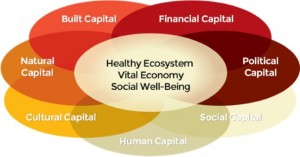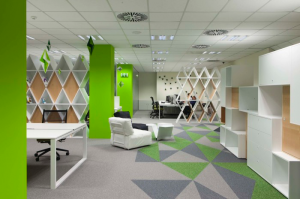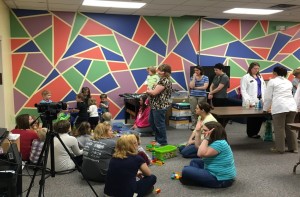Technology is changing the American workforce and workplace. The workforce is becoming more diverse, demanding multidisciplinary job skills, necessitating continuous learning, higher levels of collaborative work, and greater reliance on technology. The organization of work is adapting and promoting towards a highly educated workforce whose work products are complex problem solving and solution driven rather than traditional service delivery or product manufacturing. With these changes, workers are experiencing greater psychological demands in addition to demands for higher levels of productivity.[i] To combat these dueling demands, Extension programming is focusing on a healthy body and mind working together; the two systems work and support each other’s success.
“To succeed in a work environment of rapid change requires workers to be mentally and physically prepared, adaptable, and resilient—in a word, healthy.”
– Institute of Medicine of the National Academies
My Extension programming in Pickaway County is STEM driven,[ii] and as an Extension educator, I experience first-hand the demands of continuous learning. In order to teach effectively, educators must continue to learn; the more educators can learn and adapt, the more they can teach and innovate their Extension programming. In addition, applying more technology is critical to the learning and teaching process. Continuous learning is foundational to developing robust STEM programming that requires working across program areas and disciplines to develop healthy minds in active problem-based learning. This type of programming also requires more connections to real-world problems, employers, authentic situations, and solution seeking designs. One example is “design thinking” processes, which are vital to the incoming workforce mode of operating.
WHY?
It takes more than one subject, field, or skill to solve real-world problems. Embracing a tech driven lifelong learning approach is becoming the new norm, but only while ensuring that the body and mind are working together. A healthy active mind requires a healthy active body to carry it; again, the two systems work and support each other.

Photographed by Meghan Thoreau. FCS Extension educators and SNAP-Ed program assistants experiencing the PhysBot Wearable Technology at the 2018 FCS Conference: Building Well Connected Communities.[iii]
BODY AND MIND TECH PROGRAMS
Educator Focused PhysBot Challenges. This fall at the 2018 Annual FCS Conference: Building Well Connected Communities, I led a hands-on health tech session with the support of Patty House, educator, Ohio 4-H youth development (4-H), and Bob Horton, STEM specialist, 4-H; (presentation link). We interpreted the conference theme with a STEM undercurrent, connecting communities through applied technology. We engaged both FCS Extension educators and SNAP-Ed program assistants from across the state in wearable technology and the importance of maintaining active lifestyles, by exploring the PhysBot Data Tracker, a wearable device that tracks your body movements and health data – inspiring healthy minds at work. The PhysBot technology was developed through an Ohio-based partnership between Ohio 4-H youth development, Big Kitty Labs, and Tiny Circuits. The PhysBot kits are accessible, affordable, and include the following components:

To learn more or to order a PhysBot Kit, visit: ohio4h.org/physbots.

Youth Focus PhysBot Challenges. This winter I also developed a Body and Mind STEM Program for Teays Valley School District’s afterschool STEM Club for elementary students. The body and brain need a mix of activity and mind challenges to stay fit and productive. Teens need at least 60-minutes of activity every day, where adults can get away with 150 minutes/week![iv] Wearable technology is growing and becoming a popularized accessory for all ages. It’s estimated that in 2019 almost 90-million people in the U.S. will be wearing some form of wearable technology.[v]
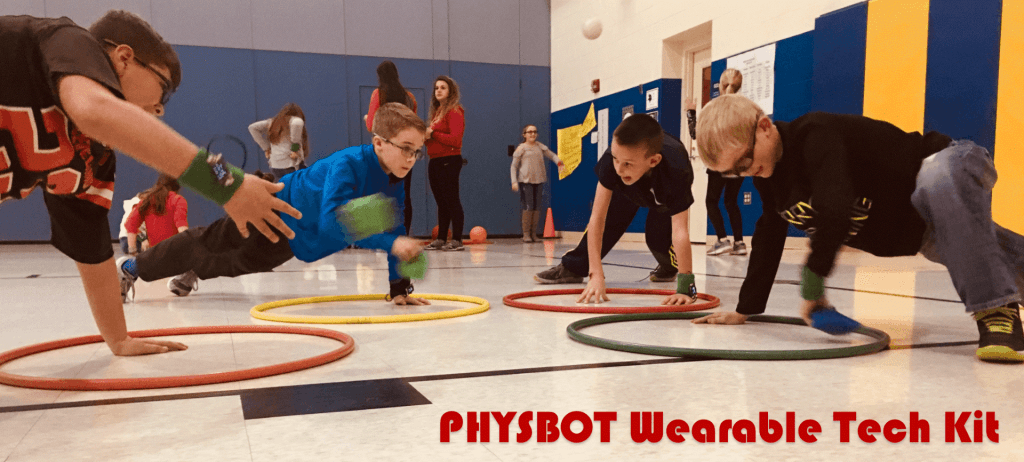
Photographed by Meghan Thoreau. Elementary students participating in STEM Club’s Body and Mind Challenges.[vi]
Produced by Meghan Thoreau. Elementary students participating in
STEM Club’s PhysBot Wearable Tech and Fitness Challenges.
The young STEMists[vii] learned that physical fitness matters, but they were also later challenged with strategic mind workouts to emphasize the importance of the body and mind working together!
“When the Pawn Hits the Conflicts He Thinks Like a King What He Knows Throws the Blows When He Goes to the Fight and He’ll Win the Whole Thing ‘fore He Enters the Ring There’s No Body to Batter When Your Mind Is Your Might so When You Go Solo, You Hold Your Own Hand and Remember That Depth Is the Greatest of Heights and If You Know Where You Stand, Then You Know Where to Land and If You Fall It Won’t Matter, Cuz You’ll Know That You’re Right.”
-Fiona Apple
International Strategic Board Game Challenges. Coming up with strategies and tactics to solve challenges and problems requires the 21st Century Skillset. November’s STEM Club programming focused on discovering new ways to plot winning strategies. These strategy activities can foster more strategic thinking skills in general that can help with real-life scenarios. Practicing strategizing skills is important, and exposing youth to international strategic board games is a means to continue playing and learning. The more these types of games are played, the better students will be at coming up with winning strategies and making smart decisions for a lifetime. The games played came from around the world: Chess (India), Five Field Kono (Korea), Backgammon (the Middle East), Fox and Geese (Northern Europe), and Mū Tōrere (New Zealand).
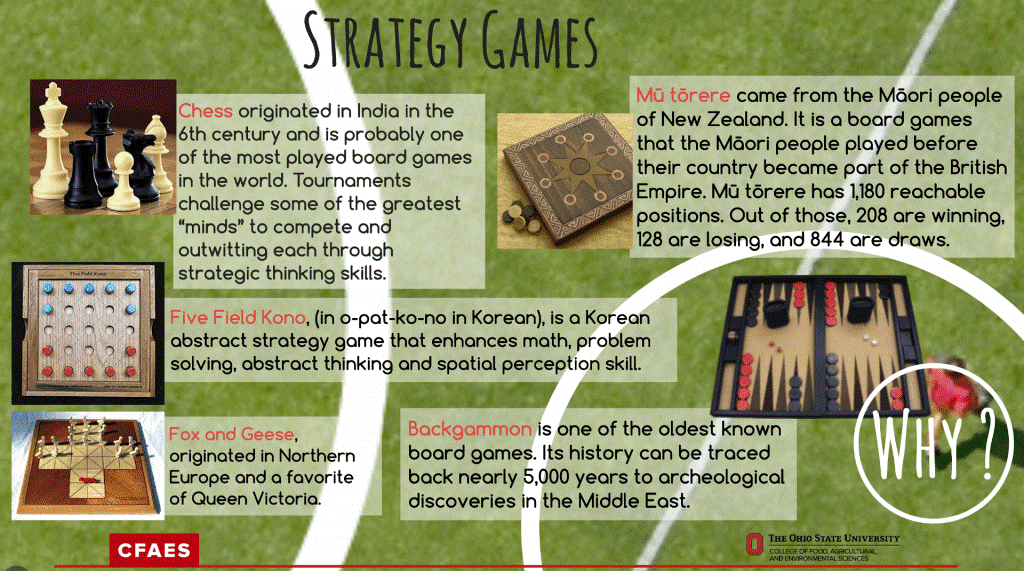
WHY ARE STRATEGY GAMES SO IMPORTANT?
Strategy games are great for learning life skills, such as patience, self-control, and thinking critically. These types of games teach emotional competence and help people learn to control their impulses; not to make a decision immediately, but rather wait for a better, more effective opportunity to present itself and act on. This mode of thinking can also help weigh through some of the psychological demands found in today’s workplace.
Strategic games help people learn to evaluate other factors at play. Players realizing that their next decision may actually cause more problems for them or may potentially lead to a strategic advantage for either them or their opponent. Strategy games also help set and maintain goals which then require many avenues of thought, and decisions have to be sorted through to remain on the goal centered path. People start thinking of the next move, but in reality, they are looking further ahead, thinking how their next move will lead to their next decision. It is that skill of anticipating the counter move that leads to making smart decisions in life. These games teach people, especially youth, to make decisions after identifying the alternatives available to them and anticipating the possible consequences. And that is the basis to critical thinking. Here is a short video highlighting the strategic game challenges:
Produced by Meghan Thoreau. Elementary students participating in
STEM International Strategic Board Game Challenges.
BONUS
The timing of the strategic game portion of the program could not have been more perfectly unplanned, because the 2018 World Chess Championship was going on simultaneously and making international headlines both in print and on the radio. Fabiano Caruana v. Magnus Carlsen – Carlsen became World Champion in 2013 by defeating Viswanathan Anand. In the following year, he retained his title against Anand, and won both the 2014 World Rapid Championship and World Blitz Championship, thus becoming the first player to simultaneously hold all three titles. He defended his main world title against Sergey Karjakin in 2016. Stories were being published like, The Magnus Effect: Norway Falls Hard for Chess, How Magnus Carlsen is Making Chess Cool and Wearing his Rivals Down, Chess on the Rise in Primary Schools, or Fabiano Caruana – the American Helping Make Chess Cool. It is important to note that Caruana is an American. The last time an American won the World Chess Championship was back in 1972 by Bobby Fischer! Ultimately, Carlsen retained his title and was victorious over Caruana, but the ripple effects of their chess matches excited the world into learning and playing more chess!
REMEMBER
A healthy worker is one who realizes that the body and mind are a working system that internally promotes a healthy worker and workforce, and advocates for a healthier community and world at large. Technology in the workplace does not lessen the need for maintaining a healthy body and mind. Healthy workers have greater stamina to live and work in America’s changing workforce.
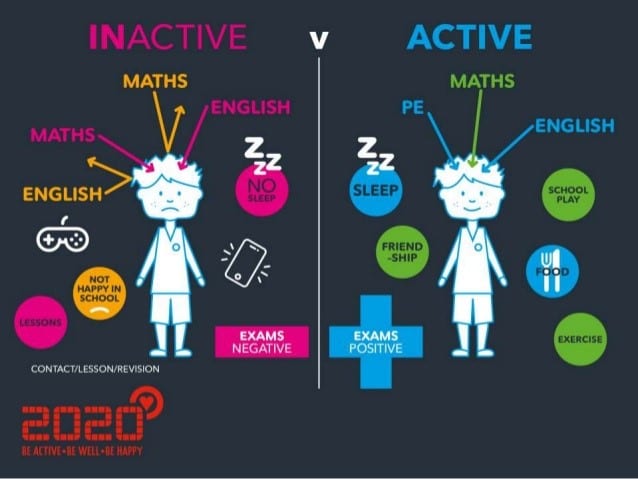
Youth Sport Trust, Working. 2016. Active Healthy Minds. 2016 Youth Sport Trust Conference Presentation.[viii]
[i] Institute of Medicine. 2005. Integrating Employee Health: A Model Program for NASA. Washington, DC: The National Academies Press. doi: 10.17226/11290. https://www.nap.edu/read/11290/chapter/5.
[ii] STEM, an acronym of disciplines, Science, Technology, Engineering, and Math, but do not get caught up on representing the correct combination; e.g. F-STEM, STEAM, STREAM, STEA2M, that becomes distracting and irrelevant to what the meaning represents. Think of STEM has a verb, stem, stemming together a multitude of any applicable disciplines to collaborating and solving the problems at hand. Solutions are derived from a blend of subjects, such as, philosophy, politics, culture, science, language, emotions, biology, the environment, anthropology, geology, etc.
[iii] Thoreau, M. October 2018. PhysBot: Tech FCS Workout Challenges. 2018 FCS Conference: Building Well Connected Communities. Marriott Airport, Columbus, Ohio.
[iv] Center for Disease Control and Prevention. 2018. Youth Physical Activity Guidelines for Americans, 2nd Edition. CDC Healthy Schools, Physical Education and Physical Activity. Retrieved at: https://www.cdc.gov/healthyschools/physicalactivity/guidelines.htm.
[v] Statista. 2018. Number of wearable device users in the U.S. 2014-2019. Technology and Telecommunication, consumer electronics. Retrieved from: https://www.statista.com/statistics/543070/number-of-wearable-users-in-the-us/.
[vi] Thoreau, M. November 2018. PhysBot: STEM Club Body and Mind Challenges. Teays Valley School District STEM Club. Retrieved from: https://u.osu.edu/tvstemclub/2018/12/13/physbot-fitness-and-strategic-board-game-challenges/
[vii] Team Groovy created the definition of the word “STEMist” because children are natural engineers and had to have a title to support their multidisciplinary applied curiosity.
[viii] Youth Sport Trust, Working. 2016. Active Healthy Minds. 2016 Youth Sport Trust Conference Presentation. Ricoh Arena. Coventry, England. Retrieved from: https://www.slideshare.net/YouthSportTrust/2016-conference-active-healthy-minds.
 Meghan Thoreau, educator, community development (CD), Ohio State University Extension-Pickaway County.
Meghan Thoreau, educator, community development (CD), Ohio State University Extension-Pickaway County.
The content of this site is published by the site owner(s) and is not a statement of advice, opinion, or information pertaining to The Ohio State University. Neither text, nor links to other websites, is reviewed or endorsed by The Ohio State University.








 increased efficiency, convenience, and personalized experiences, such business models stand to significantly impact traditional workforce and community development models. Given such challenges, how might we go about changing the way we partner with individuals, organizations, businesses and communities to secure and strengthen community vitality?
increased efficiency, convenience, and personalized experiences, such business models stand to significantly impact traditional workforce and community development models. Given such challenges, how might we go about changing the way we partner with individuals, organizations, businesses and communities to secure and strengthen community vitality?